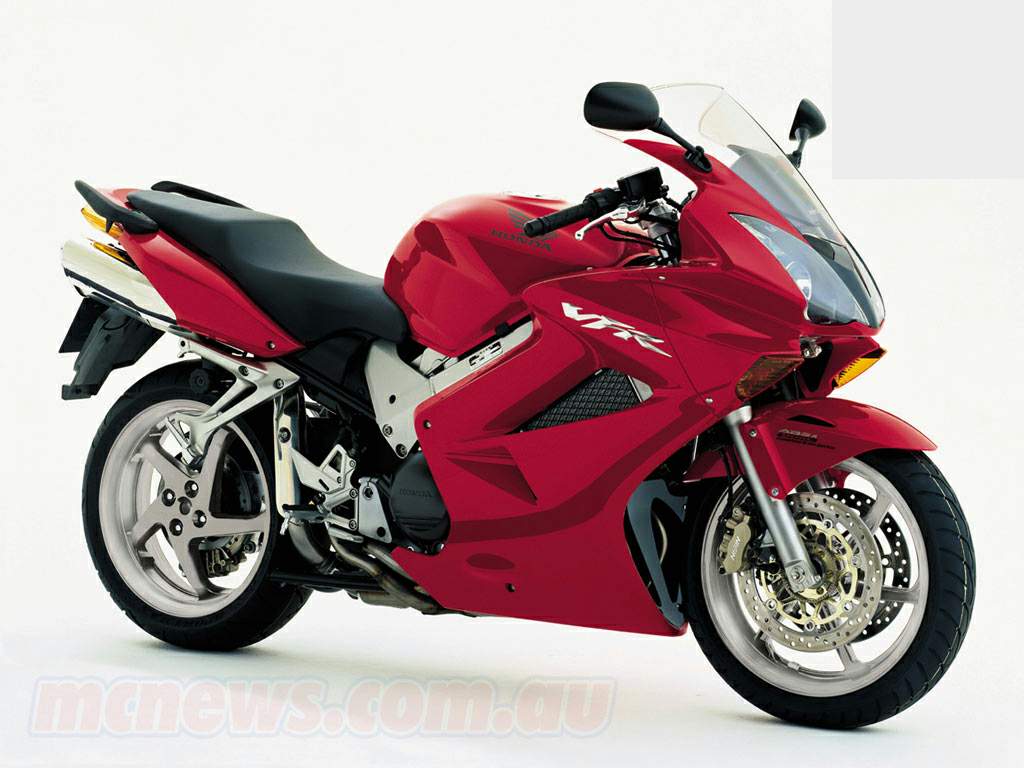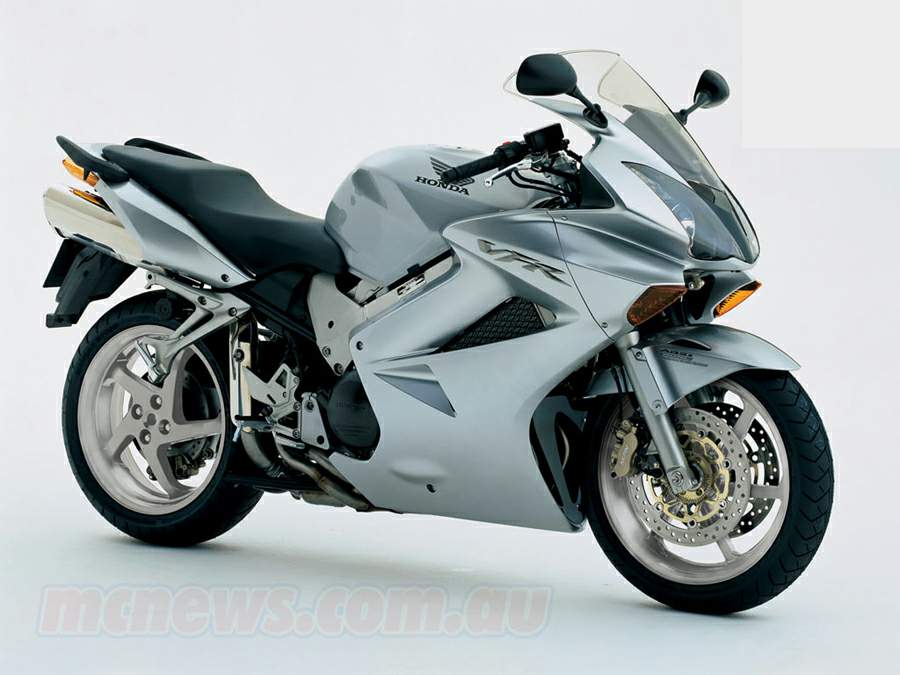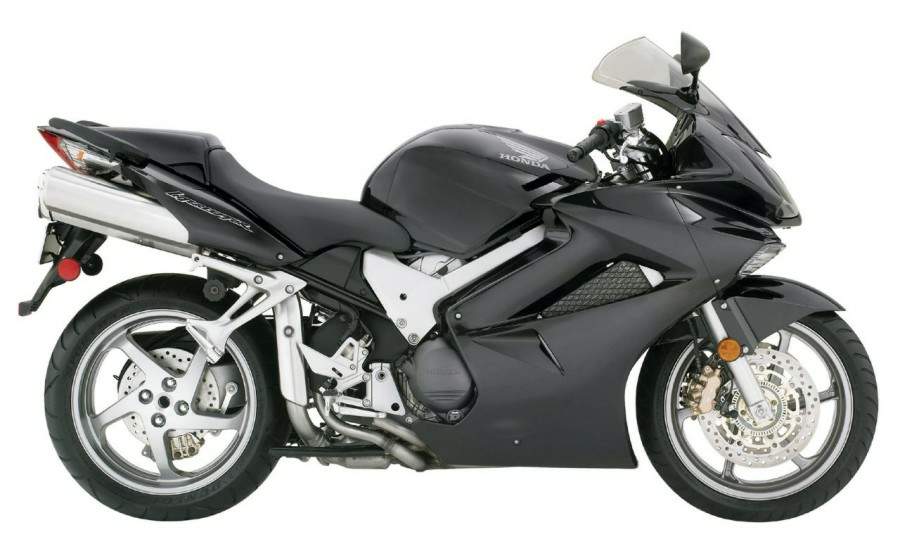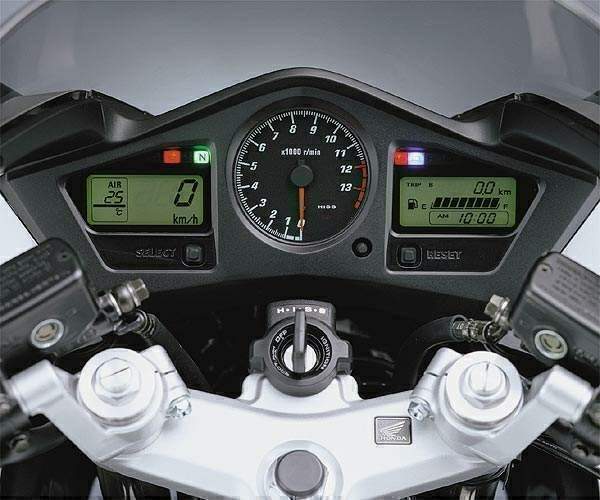
|
|
|
|
|
|
Classic Bikes
Custom Bikes
Individual
Racing Bikes AJP
AJS
Aprilia
Ariel
Avinton / Wakan
Bajaj
Benelli
Beta
Bimota
BMW
Brough Superior
BRP Cam-Am
BSA
Buell / EBR
Bultaco
Cagiva
Campagna
CCM
CF Moto
Combat Motors
Derbi
Deus
Ducati
Excelsior
GASGAS
Ghezzi Brian
Gilera
GIMA
Harley Davidson
Hero
Highland
Honda
Horex
Husaberg
Husqvarna
Hyosung
Indian
Jawa
Kawasaki
KTM
KYMCO
Laverda
Lazareth
Magni
Maico
Mash
Matchless
Mondial
Moto Guzzi
Moto Morini
MV Agusta
MZ / MuZ
NCR
Norton
NSU
Paton
Peugeot
Piaggio
Revival Cycles
Roland Sands
Royal Enfield
Sachs
Sherco
Sunbeam
Suzuki
SWM
SYM
Triumph
TVS
Ural
Velocette
Vespa
Victory
Vincent
VOR
Voxan
Vyrus
Walt Siegl
Walz
Wrenchmonkees
Wunderlich
XTR / Radical
Yamaha
Zero
Video
Technical
Complete Manufacturer List
|
Honda VFR 800F V-Tec |
| . |
|
Make Model |
Honda VFR 800F V-Tec |
|
Year |
2003 |
|
Engine |
Four stroke, 90°V-four cylinder, DOHC, 4 valve per cylinder. |
|
Capacity |
781.7 cc / 47.4 cu-in |
| Bore x Stroke | 72 x 48 mm |
| Cooling System | Liquid cooled |
| Compression Ratio | 11.6 1 |
| Lubrication | Wet sump |
| Engine Oil | Semi-Synthetic, 10W/40 |
|
Induction |
PGM-FI electronic fuel injection |
|
Ignition |
PGM-FI electronic fuel injection |
| Spark Plug | NGK, CR9EH-9 |
| Starting | Electric |
|
Max Power |
110 hp / 81 kW @ 10500 rpm |
|
Max Power Rear Tyre |
101.6 hp @ 9600 rpm |
|
Max Torque |
82 Nm / 60.5 lb-ft @ 8500 rpm |
| Clutch | Wet, multiple discs |
|
Transmission |
6 Speed |
| Final Drive | #530 O-ring-sealed chain |
| Frame | Aluminium, twin spar |
|
Front Suspension |
41mm H.M.A.S. cartridge-type telescopic fork with preload adjustable damper, |
| Front Wheel Travel | 100 mm / 4.2 in |
| Rear Suspension | Pro arm mono arm system incorporating stepless rebound-adjustable gas-charged H.M.A.S. damper with pro-link, |
| Rear Wheel Travel | 120 mm / 4.7 in |
|
Front Brakes |
2x 296mm discs 3 piston calipers |
|
Rear Brakes |
Single 256mm disc 3 piston caliper |
| Front Wheel | 3.5 x 17 in. |
| Rear Wheel | 5.5 x 17 in. |
|
Front Tyre |
120/70 ZR17 |
|
Rear Tyre |
180/55 ZR17 |
| Rake | 25.5° |
| Trail | 100 mm / 3.9 in |
| Dimensions |
Length 2,120 mm / 83 in Width 735 mm / 28.9 in Height 1,195 mm / 47.0 in |
| Wheelbase | 1440 mm / 56.7 in |
| Seat Height | 805 mm / 31.7 in |
|
Dry Weight |
208 kg / 458.6 lbs |
|
Fuel Capacity |
20.8 Litres / 5.5 gal |
|
Consumption Average |
15.9 km/lit |
|
Braking 60 - 0 / 100 - 0 |
13.0 m / 37.9 m |
|
Standing ¼ Mile |
11.1 sec / 193.0 km/h |
|
Consumption average |
18.0 km/lot |
|
Standing ¼ Mile |
11.4 sec |
|
Top Speed |
239.8 km/h / 149 mph |
| . |
The VFR800 inherited its position as class leader in the sports-touring sector from its 750cc predecessor. Although its roots go back to the first VF750 of 1982, the latest VFR800 is one of the most accomplished and advanced motorcycles produced.
The V-4 engine at the heart of the VFR uses a VTEC variable valve system which alters the valve opening behaviour to give different power characteristics depending on engine speed. Below 7000rpm, only two of the four valves in each cylinder are opened by the camshafts. This two-valve layout gives superior torque and power production at low revs, where intake gas velocity is more important than large valve time-area values. But at higher revs (above 7000rpm) a computer-controlled valve pushes locking pins into place.
These pins engage the remaining two valves in each cylinder, and the engine takes on the characteristics of a four-valve design. The extra valve time-area is perfectly suited to high-speed power production.
The VFR also features Honda's PGM-FI fuel-injection system, which boosts power, economy and clean-running, as well as a catalyzing element in the exhaust system to further reduce pollution.
The chassis combines sporting ability with touring practicality. A 'sport' version of the CBS linked brakes gives a more suitable blend of stopping power front and rear, while an optional ABS braking system provides extra security on unpredictable
road surfaces. Adjustable 43mm (1.7in) front forks and the single-sided monoshock rear suspension give superbly damped handling, and while the VFR is heavier than many sportsbikes, it disguises the extra mass well once on the move.
The broad dual seat is comfortable for many miles, even with a pillion, and the angular bodywork keeps the worst of the weather off. A generous 22-litre (4.8 gal) fuel tank, together with the efficient VTEC engine allows an impressive 322km (200 mile) range between refills. Optional accessories like hard luggage, heated grips and taller screens further enhance the VFR's touring ability.

Review
Those of you of a certain age will remember a
snooker player called Steve Davis. Nice guy, and very successful, but not
exactly what you would call an exciting player to watch. He just did the job,
very efficiently, and collected prizes. There was a photocopier company who used
him in their TV ads - "Boringly reliable copiers" was their tagline. The general
opinion, certainly among my esteemed colleagues in the motorcycle press, seems
to be that the VFR is the Steve Davis of motorbikes. Worthy and capable, yes,
but also rather dull. Not, I have to say, that the public found that to be a
problem. The VFR has always been a good seller here, perhaps because you, the
buying public, are more interested in getting something that will do what you
need rather than the latest fashion tool. Which is a good thing. Perhaps you
also remember Ron Haslam taking a totally standard VFR from a dealer and
acquitting himself extremely well at a very wet 1985 Transatlantic race weekend
at Donnington against full blown factory racers. Oh yes - the VFR may have been
dull and dependable but it has always been fast and been blessed with better
than average handling.
This latest incarnation of the VFR has a little extra something. VTEC, Honda's
variable valve timing, has been around in one form or another for ages, although
you're probably more used to seeing it in a car than on a bike. Engines biased
towards touring have their valve timing set to produce optimum power and torque
without relying on revs, the result being that they soon run out of steam when
things get more frantic. Sportier engines have a valve timing that makes them
far more efficient at higher revs, producing far more power with similar torque,
but being typically gutless at slower speeds. The principle of VTEC is easy
enough - at lower revs the valve timing is softer and at a certain point the
timing changes to unleash the rev monster that was always lurking in there. In
the VFR, this happens at 7000rpm and is accompanied by both a distinct change in
noise and in attitude. Mild mannered Bruce Banner, if you like, has got cross
and turned into The Hulk. Well, that may be overdoing it a bit. Boringly
reliable Steve Davis has turned a little nasty. And he's all the better for it,
too.
There's a bit more going on here than initially meets the eye. Put simply, the
numbers don't add up properly. Riding the bike makes it very clear that this
latest V-four is blessed with ample power, it is a beautifully torquey motor and
the bike itself is light and well balanced. Which would be fine except that the
bare figures suggest the engine isn't particularly powerful, isn't especially
torquey and is bolted into a bike on the heavier end of the genre. Now I don't
know how Honda have pulled this trick off, but they've done it very convincingly
indeed. The VFR pulls well from low revs and has a beautifully linear power
delivery right up to, and indeed slightly beyond, the red line. There is a step
when the V-TEC kicks in, but how much of that is psychological as the noise
changes so dramatically I can't be sure. I'll just say that I never once found
the VFR lacking in performance or flexibility.
Now at various times in the past I have referred to preconceptions, and this is
a bike about which there must be more than most. Many people will say that the
VFR is boring. That it is just so capable that it isn't exciting, that it is
somehow less of a bike because it can seriously be considered all things to all
people. Not true. None of it, in fact. It isn't boring - nothing with this sort
of performance could be fairly be called boring. It is incredibly capable, but
that doesn't detract from the fact that you can have a laugh on it. There is no
way that it could really be all things to all people - in fairness it will do
everything as well as most riders could handle, but then again so will just
about anything else that isn't a scooter or a learner special. But the majority
of the biking public's preconceived prejudices are reserved for one particular
feature of the VFR. Linked brakes. Honda have been using them for a while, and
it's interesting that when Moto Guzzi had them on their entire range, including
the fire breathing Le Mans, back in the 80's, enthusiasts raved about how great
they were. Why, then, is everyone so set against Honda doing the same thing? Not
something I can objectively answer, because I was firmly entrenched in the same
mindset. I don't like linked brakes because, well, just because. My Guzzi had
them and they were fine. But now, 20 years on, I don't like them. Well, that
isn't totally true. In fact, if you listen carefully you can hear the rare sound
of a journalist eating his words and admitting that, shock, horror, he was
wrong. Yes, it's true. While I didn't notice any massive improvement from having
them, I didn't notice any downside either. The VFR brakes are pretty much like
the rest of the VFR. Effective, usable and perfectly integrated.

For the record, by the way, Honda cite the following
as the main reason behind fitting linked brakes: "The CBS system, in most
emergency situations, offers greater braking efficiency than a conventional
system. For example,a rider performs an emergency stop only using the front
brake lever. As the system is linked they will get some additional, and
proportional, braking force from the rear, without even thinking about it."
Well, it seems perfectly reasonable and certainly doesn't have any adverse
effects that I could find. If you can think of a downside, would you let me
know, please?
Right, enough pontificating, let's actually ride the thing.
Moving the VFR around before getting on, the first thing that strikes you is the
lack of apparent weight. It really is extremely well balanced. Something else
that strikes you will be the, um, distinctive appearance. Well, at least Honda
can't be accused of putting form ahead of function.
Once in the saddle, everything falls readily to hand. No, I mean everything is
exactly where you want it to be. Again, I don't know how Honda do it, but they
seem able to make a bike that fits everyone perfectly straight away. It's a neat
trick. Start the engine, look at the tacho to be sure it really has started -
yes, it really is that quiet and smooth - get yourself settled and off you go.
Pulling away the VFR is smooth but not exactly ripping the tarmac up. Build a
bit more speed and the fairing shows that yes, it works quite well. The mirrors
don't blur at all and give a pretty reasonable view. Instrumentation is
admirably clear, with a large and quite accurate fuel gauge, twin trip meters,
clock and air temperature gauge. If your journey happens to be taking place at
night, you will be treated to the best headlights I have ever seen on a bike.
They are way better, even, than most car drivers get to use. Pretty they are
not, but my word they're effective.

At some point it's quite likely that you will encounter a corner. This, at least
on the VFR, is a Good Thing. The handling was, to be honest, a bit of a surprise
- I was expecting something that would handle reasonably well, but I wasn't
expecting something that would take one of my favourite stretches of road as
fast and as composed as any top end sports bike. I failed to provoke a weave or
any misbehaviour at all - the VFR simply did as it was asked without fuss or
drama. This seemed to be the case solo or two up - the VFR is simply unfazed by
whatever you throw at it.
Getting between the corners isn't a big deal either. There is plenty of power,
although things get more interesting with higher revs, and once the V-TEC has
kicked in there is plenty to sustain an enthusiastic pace without resorting to
frantic gear changes. Should you decide to work the box, though, you'll find
that it is smooth and effective. Which probably isn't much of a surprise.
There is, astonishingly enough, one area where it is just possible that Honda
have allowed form to intrude over function. Underseat storage is, to all intents
and purposes, non existent. Oh sure, you can get the toolkit in there, and
there's room for a puncture kit as well, provided it's a small one, but that is
about it. Not a huge issue on a bike like this but it is a surprise nonetheless.
Some bikes just reach out and grab you. Some make you fall in love with them
because of their looks. Some seduce you with their character. The VFR does none
of these things. I did just over 800 miles on the VFR in the week we had it. I
never once found anything that it wouldn't do (although I didn't try taking it
off road) and found quite a few things it would do far better than I had any
right to expect. During this time I tried to rationalise how I felt about it.
But I couldn't. I didn't fall in love with it because of it's looks because I
don't find it that pretty. It didn't seduce me with it's character because it,
um, doesn't have much. And it didn't reach out and grab me because that sort of
thing would somehow be too vulgar for it. And yet I could quite happily live
with one, and I can easily see how so many people buy a VFR and then never want
anything else.
Quite simply, it's a fabulous bike.
SB
2nd opinion by Adrian Percival
The Honda VFR has always been one of my favourite bikes. It's a comfortable and
surpisingly sporty bike to ride and yet is one of the few bikes you can honestly
blast off for breakfast, take the long way for lunch and then look for the
longest way home for dinner.
Honda has introduced many technological advances to the VFR over the years, but
when I saw the first pictures of the new VFR I was stunned! I just couldn't
believe what they had done. When I first saw it in the flesh I still wasn't
convinced. It's a bike that grows on you the more you ride it, and the more you
just stand a stare at it!
The new VFR is probably the most advanced sports/tourer we have seen yet, with
many new features including the infamous variable valve technology (VTEC).
Simply put, the VTEC engine runs on two valves per cylinder below 7,000 rpm then
cuts into four valves per cylinder above 7,000.
The first thing you notice when you climb aboard, is the seating position. It's
pretty much the same as its predecessors, but the pillion pegs are now 10mm
lower, thanks to the new exhaust location. The rider has a new seat which is
some 15mm wider for better comfort and the rear grab rails are 10mm wider. I had
a chance to sample the pillion passengers view on a trip into London from
Oxfordshire, all I can say is that it was very easy and comfortable for
reasonable length trips, and the grab handles did exactly what Honda designed
them to do.
The new 'VTEC' VFR is a very together package. Most bikes in this area of the
market offer much larger engines than the 781cc VFR, but not many provide such a
level of technical sophistication and refinement. It has plenty of power to get
by in any road based situation but if I had one criticism to make then it would
have to be the lack of any torque under about 3000rpm. This is not a problem on
most other sport tourers in this class due to the engine size difference, but
that aside it is an absolute howl when you get it over that low torque
threshold. I seemed to spend most of my time on the bike at around 7000rpm
sampling the delights of the VTEC and listening to the engine note change as the
power rush started!
VFR fans of old will not be disappointed with this new improved version, I
wasn't and I have had 4 over the years. If you can only afford one vehicle to do
everything then the VFR is still one of the smartest moves you could make.
Source Motorbikes Today

|
Any corrections or more information on these motorcycles will be kindly appreciated. |